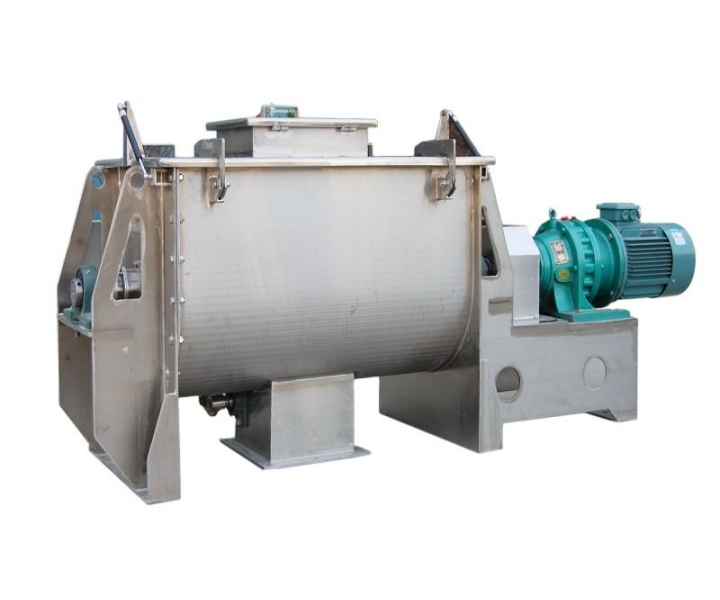

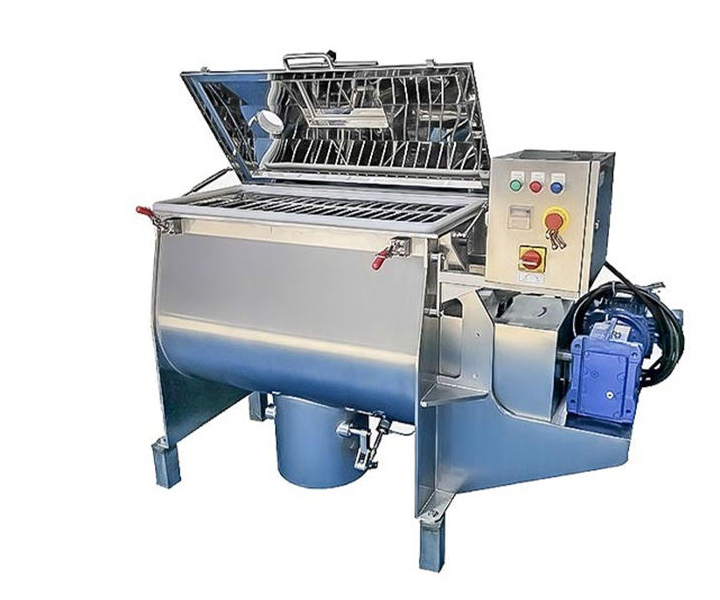






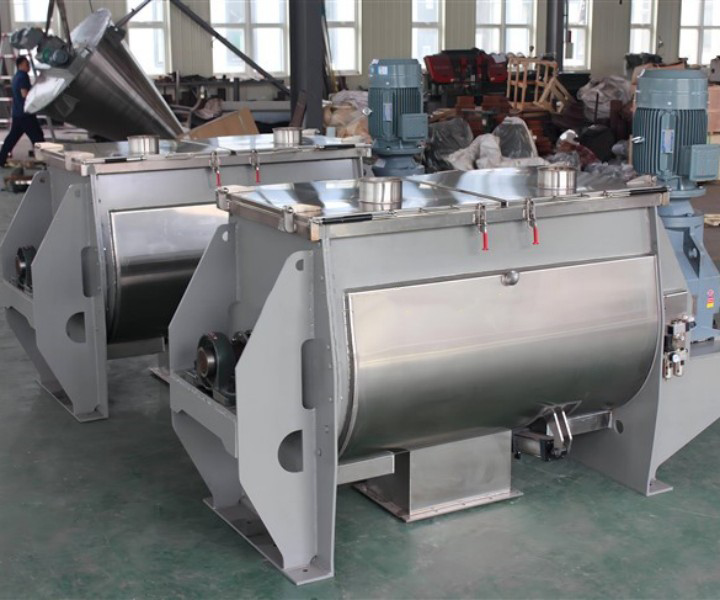
Short mixing times and optimal mixing quality for consistent batch and continuous mixing of powders, granules and liquids
![]()
![]()
Price:$2,000.00-$9,000.00/Set
Consult now and enjoy a 10% discount
Mixing time: 8-20min
Capacity: 500L-10000L
Weight: 100kg-7500kg
One-time mixing:100-6000kg
Configuration: Standard paddle, fluidized paddle, ribbon, mixer or chopper
Material: Carbon Steel, AISI 304L Stainless Steel and 316L Stainless Steel
Application: Feed manufacturing, animal nutrition, food manufacturing, chemicals, plastics, pet food, cement/aggregates
Commitment: 1Free Shipping/5 Days Delivery/30-Day Returns/Support Customization
Horizontal mixer is a common mixing equipment whose design feature is that the mixing shaft is placed horizontally inside the container. It mixes the materials evenly through the rotation of the stirring shaft and the movement of the stirring blades. Horizontal mixers are suitable for mixing materials of different forms such as solids, liquids and powders, and are widely used in chemical industry, pharmaceuticals, food processing, environmental protection and other fields.
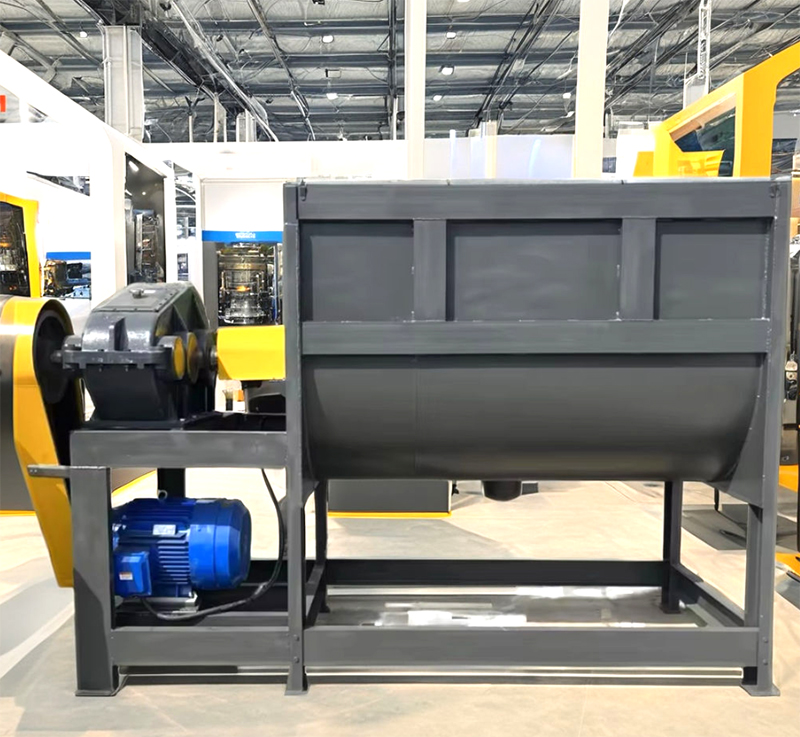
The advantages of horizontal mixers include simple structure, easy operation, and good mixing effect. It can quickly and evenly mix materials with different properties to ensure the consistency and stability of the mixed materials. In addition, the horizontal mixer also has flexible adjustment performance, and can meet different process requirements by adjusting the rotation speed of the mixing shaft and the structure of the mixing blades. Therefore, horizontal mixers are indispensable and important equipment in many industrial productions and laboratory research.
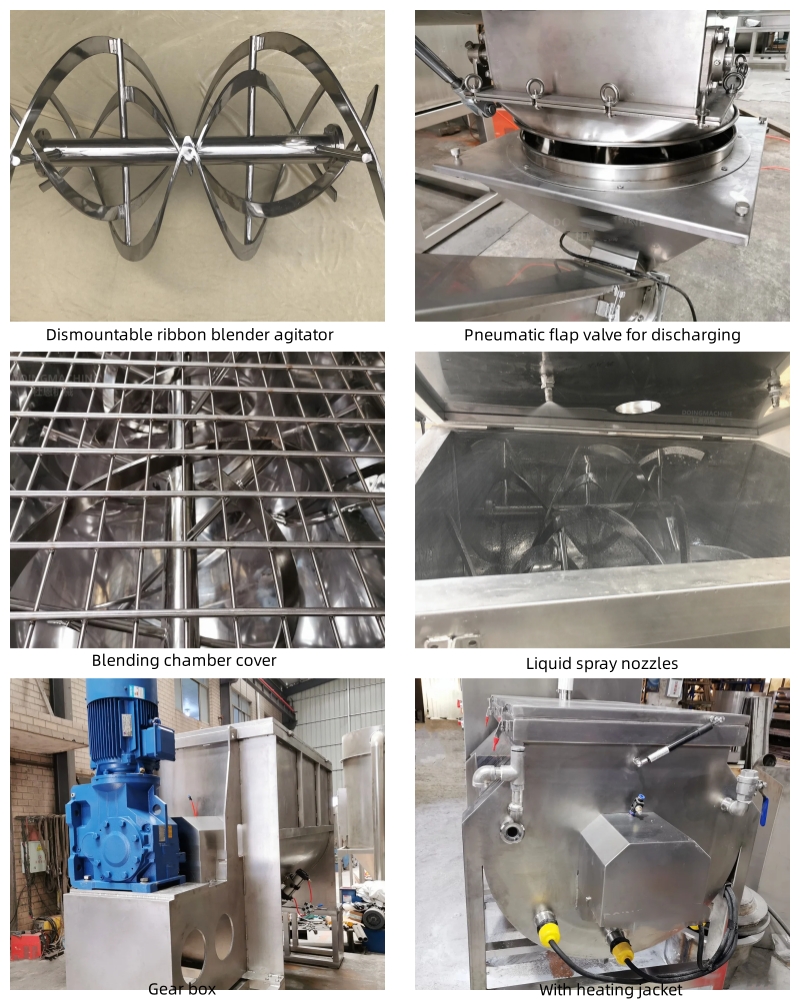
Horizontal mixers are widely used in many fields, the following are some of the main fields:

Chemical engineering: Horizontal mixers play an important role in chemical engineering. It is used for mixing and stirring various chemical substances such as solutions, suspensions and powders. Applications in the chemical industry include pharmaceuticals, coatings, pigments, dyes, plastics and rubber.
Pharmaceutical production:In the pharmaceutical industry, horizontal mixers are widely used in the mixing and preparation process of drugs. It can mix different pharmaceutical ingredients evenly to ensure the consistency and quality of the medicine. In addition, horizontal mixers can also be used for stirring and mixing reaction materials in pharmaceutical reactors.
Food Processing: Horizontal mixers have important applications in the food processing industry. It is used to mix and stir food raw materials such as flour, liquid ingredients, seasonings, etc. to prepare various food products such as bread, biscuits, sauces, etc. Horizontal mixers ensure uniform distribution and stable quality of food ingredients.
Environmental protection: In the field of environmental protection, horizontal mixers are used to treat wastewater, waste liquid and solid waste. It can evenly mix waste with other treatment agents, promote chemical reactions, degrade or decompose harmful substances, and improve treatment efficiency.
Metallurgical industry: Horizontal mixers are often used in the leaching, soaking and reaction processes of ores in the metallurgical industry. It can fully mix the ore with the solution or soaking agent to improve the metal extraction efficiency and reaction speed.
Building materials: In the building materials industry, horizontal mixers are widely used in the preparation of materials such as concrete, mortar and gypsum. It thoroughly mixes cement, aggregates and other additives to ensure uniformity and strength of concrete and mortar.
Mixing shaft and blades: Horizontal mixers usually include a horizontally placed mixing shaft with mixing blades installed on the shaft. The stirring shaft is driven to rotate by a motor or other power source.
Material feeding: Materials are fed into the container of the horizontal mixer through the feeding port. The feed opening is usually located at the top of the container.
Stirring motion: When the stirring shaft starts to rotate, the stirring blades move accordingly. The movement of the mixing blade can be divided into two directions: radial and tangential. Radial motion pushes material outward from the center of the container, while tangential motion stirs material along the walls of the container.
Mixing effect: The movement of the stirring shaft and blades causes the materials to continuously collide with each other and exchange positions inside the container, thereby achieving uniform mixing of the materials.
Discharge: After mixing is completed, take out the mixed materials from the horizontal mixer through the discharge port. The outlet is usually located at the bottom of the container.
Efficient mixing
Horizontal mixers can mix materials together quickly and evenly. The movement of the stirring shaft and blades ensures full collision and exchange of positions of materials, promotes the mixing process and improves mixing efficiency.
Uniformity
Horizontal mixers can achieve uniform mixing of materials. The design and arrangement of the mixing blades enable the materials to be stirred in multiple directions inside the container, ensuring that materials with different components are evenly distributed and improving the consistency of the mixed materials.
Flexible adjustment
The horizontal mixer has flexible adjustment performance. The rotation speed of the mixing shaft, the structure of the mixing blades and the design of the container can be adjusted to adapt to the mixing requirements of different materials and meet different process and production needs.
Simple and reliable structure
The structure of the horizontal mixer is relatively simple and easy to operate and maintain. It usually consists of a mixing shaft, mixing blades and a container. There are no complicated transmission devices and control systems, which reduces the possibility of failure and improves the reliability of the equipment.
Widely applicable
Horizontal mixers are suitable for mixing materials with different particle sizes, densities and properties. It can handle materials in various forms such as solid, liquid and powder, and is widely used in many fields such as chemical industry, pharmaceuticals, food processing, and environmental protection.
Improve reaction efficiency
Horizontal mixers can not only mix materials, but also improve reaction efficiency. In the fields of chemical industry and pharmaceuticals, horizontal mixers are often used in reactors to promote the contact and reaction of reaction materials through stirring, speed up the reaction rate, and improve production efficiency.
Vertical mixers and horizontal mixers are two common mixing equipment, and they have some differences in structure and use. Here are the main differences between Vertical mixers and horizontal mixers:
| Comparative Item | vertical mixer | horizontal mixer |
 |
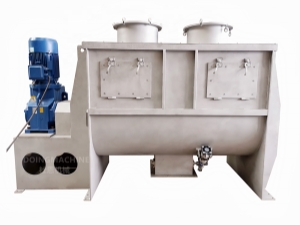 |
|
| Structural form | The stirring shaft of the vertical mixer is vertically upward or downward, and the container is usually cylindrical or conical. | The mixing shaft of a horizontal mixer is horizontal, and the container is usually a cylindrical or oval shape placed horizontally. |
| Mixing method | The mixing blades of the vertical mixer are usually fixed on the mixing shaft, and the materials are mixed by the rotation of the mixing shaft. | The mixing blades of the horizontal mixer mix the materials through the rotation of the mixing shaft and the movement of the mixing blades, with both radial and tangential motion. |
| Scope of use | Vertical mixers are suitable for mixing tasks with smaller capacities and are commonly used in laboratories, small-scale production and special process requirements. | Horizontal mixers are suitable for larger-capacity mixing tasks and are widely used in chemical, pharmaceutical, food processing and other fields in industrial production. |
| Material fluidity | Since the vertical mixer container is usually cylindrical or conical, the material has good fluidity in the container and is easy to achieve uniform mixing. | The shape of the horizontal mixer container may have a certain impact on the fluidity of the material, and it needs to be designed and adjusted according to the properties of the specific material. |
| Container installation | Vertical mixers usually need to be fixed to the ground or other support structures to ensure the stability of the equipment. | Horizontal mixers can be placed directly on a horizontal workbench or the ground. |
| Equipment occupied space | Since the mixing shaft of the vertical mixer is vertical, the overall height of the equipment is high and the space occupied is relatively large. | The mixing shaft of the horizontal mixer is horizontal, the overall height is low, and the space occupied is relatively small. |
| Model | LHY-0.25 | LHY-0.5 | LHY-1 | LHY-1.5 | LHY-2 | LHY-3 | LHY-4 | LHY-6 | LHY-8 | LHY-10 |
| One-time mixing (kg) | 100-150 | 200-300 | 400-600 | 600-900 | 800-1000 | 1200-1800 | 1600-2400 | 2400-3600 | 3200-4800 | 4000-6000 |
| Mixing time (min) | 8-20 | 8-20 | 8-20 | 8-20 | 8-20 | 8-20 | 8-20 | 8-20 | 8-20 | 8-20 |
| Mixing speed (r/min) | 60 | 55 | 45 | 40 | 35 | 25 | 25 | 20 | 15 | 15 |
| Motor power (kw) | 3-5.5 | 4-11 | 7.5-15 | 11-18.5 | 15-22 | 18.5-30 | 22-37 | 37-55 | 37-55 | 45-75 |
| Weight (kg) | 500 | 900 | 1800 | 2500 | 3200 | 4100 | 5100 | 6300 | 7500 |
Material selection
The materials include stainless steel, carbon steel or other special materials. Stainless steel has the advantages of corrosion resistance and easy cleaning, and is suitable for industries such as food and medicine; carbon steel has a lower cost and is suitable for general industrial applications.
Mixing material selection
When mixing powder materials, you can choose a horizontal mixer with a spiral stirrer. When mixing granular materials, a horizontal mixer with a stirring blade is more suitable. When mixing viscous materials, you can choose a horizontal mixer with a scraper stirrer. When mixing oxidizable materials, choose a horizontal mixer made of stainless steel.
Discharge port location selection
Discharge port of horizontal mixer can be placed in different positions according to design requirements, including bottom discharge port (material is discharged from the bottom downward, which is convenient for emptying the mixing barrel), side discharge port (suitable for some occasions where lateral discharge is required), and top discharge port (usually controlled by rotating or tilting the mixing barrel. Suitable for situations where the flow direction of materials needs to be controlled during the mixing process).
Agitators selection
The agitator is the most important component of the mixer, and we offer several options: Double Ribbon Multi-Pitch, Double Ribbon Standard, Single Ribbon Agitator, Paddle, Trowel.

Variable processes with frequent product changes
Horizontal mixers are optimally suited for variable processes and frequent product changes. These horizontal mixers induce mechanical turbulence or, alternatively, process aggregate mixtures. The task of the mixer is to deliver a homogeneous mixture featuring an extremely small variation coefficient within a batch time (loading/mixing/discharge) of between 5 and 20 minutes. Horizontal mixers are available in various designs, depending on your requirements.
Continuous processes with large throughput volumes
Horizontal mixers are excellently suited to large throughput volumes in continuous processes. Our robust technology allows for 24-hour continuous operation, 365 days a year. The raw materials are fed continuously via appropriate dosing units and nozzles, and the finished mixture is continuously discharged via suitably designed discharge elements.
When purchasing a horizontal mixer, there are several important considerations to consider:

Mixing needs: First of all, you must clarify your own mixing needs, including the type of mixed materials, capacity requirements, mixing effects, etc. Different mixers may be suitable for different materials and mixing requirements, so make sure you choose a horizontal mixer that meets your specific needs.
Quality and brand: Choose a mixer brand with good quality and reputation to ensure the reliability and durability of the equipment. Research and compare different brands of blenders, check out their user reviews and customer feedback, and choose trustworthy suppliers and manufacturers.
Equipment parameters: Pay attention to the key parameters of the horizontal mixer, such as capacity, mixing shaft speed, power, etc. Make sure these parameters match your mixing needs and meet your production requirements.
Safety and ease of operation: Check the mixer's safety features and guards, such as emergency stop buttons, safety doors, etc. In addition, choose a mixer that is easy to operate and maintain to reduce the difficulty of use and maintenance.
Service and support: Understand the after-sales service and support provided by the supplier, including warranty period, technical support and spare parts supply. Ensure there is a reliable after-sales service system in place so that timely support and repairs can be obtained when needed.
Budget and cost-effectiveness: Consider your budget constraints and find a balance between quality and performance. Evaluate the cost-effectiveness of different blenders and choose the option that best suits your needs and budget.

A food processing company specializes in the production of flour products. In order to improve production efficiency and product quality, it decided to purchase a horizontal mixer. They needed a mixer with the right capacity to evenly mix flour and other ingredients to ensure product taste and quality. After cooperating with suppliers, a horizontal mixer that met the needs was selected, which improved production efficiency and product quality.
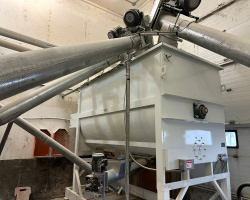 |
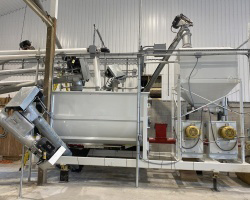 |
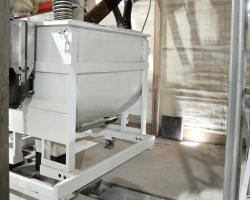 |
 |
| FEED PRODUCTION FARM SITE | FEED ROOM INSTALL | HOG FEEDING OPERATION | FARM FEED MILL SETUP |
| A variety of equipment was added to farm site to help speed up their feed production process and allow the farmer to easily ship out feed to other farms. | This feed room install from features a complete feed batching system. This skid includes a two ton horizontal mixer with a pair of 25 hp hammer mill’s and a surge hopper with supporting augers. | Demonstrate the application of horizontal mixer in pig feed feeding operation, how to mix different types of feed to meet the nutritional needs of pigs. | Check out this farmer-operated feed mill setup. Workers put various feed raw materials such as corn and soybean meal into the mixer and mix them by stirring to ensure that the various nutrients in the feed are evenly distributed. |
Address:China,Yanjin county forest park gate to the west 1000 meters north road.